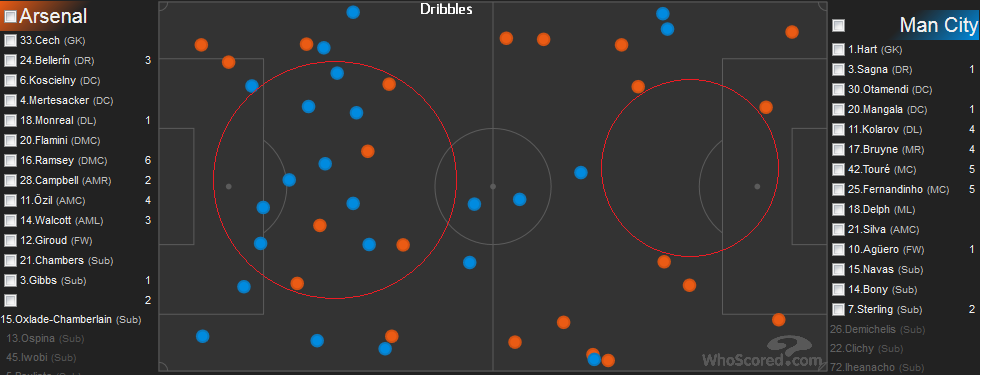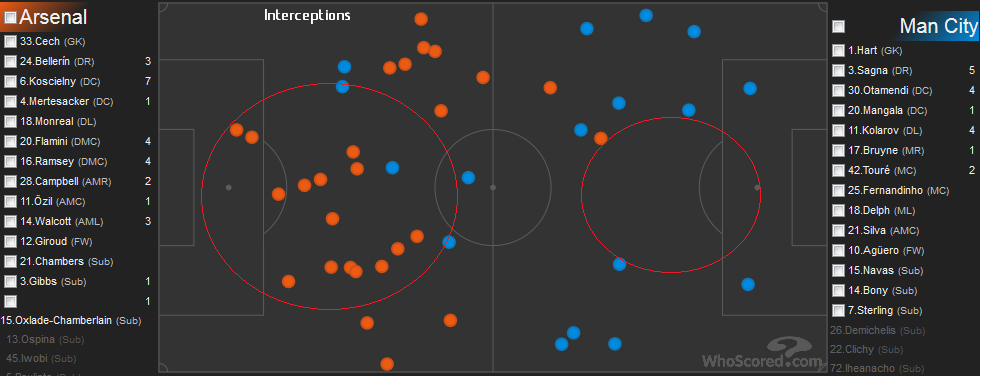Set up as being one of the biggest matches in the title race so far this season, Manchester City travelled to the Emirates with no win and only one goal in the previous four away league matches. They lined-up in what was effectively a 4-4-1-1 formation, with Silva playing in the number 10 role behind Aguero. Toure and Fernandinho occupied the central midfield positions and, somewhat surprisingly, Delph and De Bruyne were the wide men. Looking to close the gap to Leicester at the top, Arsenal fielded a similar shape, but with more traditionally advanced wingers in Walcott and Campbell. Ozil continued behind Giroud, with Ramsey and Flamini holding in the middle.
Arsenal started with some early possession, as the game began at a pretty slow tempo. It was understandably cagey, with a lot riding on the result for both teams, and neither wanting to give a psychological boost to the other in leaving gaps open at the start of the game. A main talking point was Pellegrini’s decision to start Delph on the left instead of Sterling. Some saw this as a negative move, but it was one that helped keep Bellerin contained in the first half, and ended up forcing most of Arsenal’s attack down the other flank. Even at 4 minutes into the game, you could see Toure pointing to Delph and the gesturing to the space he needed to cover down the left – an area that the manager had clearly highlighted to them before the game. City had a couple of chances to find a route to goal, with De Bruyne running with the ball through the middle early on and and then a cut back on Silva on the edge of the box who shot over. The Spanish playmaker found himself with a fair amount of time on the ball on that occasion, but this was a rarity throughout most of the game, as he was closely marshalled by Flamini, and the Arsenal defence were generally good at holding their shape – not allowing Silva to drift between the lines to affect the play. Flamini was seen on several occasions pointing and organising his team in front of him when on the back-foot. It seemed to work pretty well, and although Ramsey came deep to collect the ball, he was the one who looked forward, while Flamini was holding as opposed to being fully box-to-box.
A common occurrence in the opening periods of the game was Koscielny moving out of defence with the ball, over the halfway line, and looking to play straight passes into the front-men (shown below). Often this would be Ozil finding space in front of City’s defence and losing the attachment of Toure by drifting left. We saw it at least four times in the first 25 minutes – Koscielny picking up the ball and moving forward, then looking to try and find someone in the final third to slot the ball to. It was an effective transition between defence and attack, and one that was able to offer a direct route to goal with Ozil being able to receive the ball, turn and pass without being pressured into a mistake. It was a bit surprising that Pellegrini didn’t do more to suppress the threat of Ozil’s movement, but Toure wasn’t disciplined or deep enough to stick to him, and as much as Otamendi likes to engage the ball and be pro-active, his focus was usually Giroud. A makeshift option may have been to switch Toure and Fernandinho to allow the latter to try and block that ball that Koscielny was consistently looking for. However, by 33 minutes it was too late, as Arsenal exploited this route for the first goal. Interestingly enough, Fernandinho was actually over that side of the pitch this time, but not quite far enough to cover off Ozil, who received Koscielny’s pass to feet, turned and passed. Walcott picked it up and bent a fantastic strike inside the far post to put the home team in front.
Manchester City had their moments, and looked threatening at times, mostly through De Bruyne coming in from the right-hand side. They had the best chance to take the lead, before Walcott’s goal, when the Belgian broke with the ball in a counter and had two men in support. He chose to run at goal and shoot just wide from a slight angle, when engineering a square pass would have probably been a better option. This was the chance that Pellegrini will look back on as the one that could have changed the shape of the game at the time. It had all come about from a ball in to Aguero, who flicked it on to De Bruyne to run at goal. Koscielny left a big gap where he had tried to push right up on Aguero, but failed to intercept the ball, allowing De Bruyne a good route to goal. The chance came at a time when the game began to open up a bit and the tempo only increased after the first goal. Aguero was struggling to have much of an impact up front, as Arsenal’s shape was kept pretty solid, getting men back behind the ball on defence. The away side lacked any real height in the box, and struggled without having the aerial presence to offer a different dimension to their play, other than De Bruyne’s free-kicks. Their only real opportunity at this was from corners, but De Bruyne’s outswingers didn’t pose much of a problem for the defence. In contrast, although there weren’t a huge amount of opportunities for the home side either, Giroud always offers himself in the box and makes a nuisance of himself. He did a great job of holding up the ball on occasions tonight as well (classic example Ramsey chance second half). The one corner that Arsenal did have before half time was one from Ozil that was met by Koscielny and nearly caused a problem as it just went past the post.
Before half-time, City were having a reasonable amount of possession inside Arsenal’s half, and the home side were dropping back into a defensive shape to contain their attacks. This left them with the threat of the counter-attack once they regained the ball, and also meant that Silva and Aguero had very little opportunity to find gaps between the lines. It was an effective way to operate before half-time, as City found it very difficult to unlock their defence and create a chance on goal. Arsenal’s ability to engage any attackers near the penalty area, and persistence on getting close to their men, meant that chances were limited before they could regain possession and re-assess the tempo of the game. Then, just before the break, came the all-important second Arsenal goal. It came through a mistake by Mangala, giving the ball away inside his own half with a sloppy pass. The ball was played into Ozil who turned and weighted a perfect pass through to Giroud, for him to drill low into the net. It was typical from Ozil, as he found space between Man City players to receive the ball and slip in his mate who struck like a man full of confidence (see below). The goal gave Arsenal breathing room and triggered a reaction from Pellegrini at half-time.
That reaction came in the form of Raheem Sterling, who may have expected to start the match, replacing Fabian Delph. It was clearly an attacking move, albeit not an unexpected one, but a change that opened up that side of the pitch. Arsenal started the half in the ascendancy and Bellerin got forward down the right straight away. Kolarov didn’t have that same protection from Sterling that Delph offered. This could have inadvertently caused more problems, if Fernandinho moved further out to cover for Sterling, exposing Toure (and his lack of tracking back) in the other central position – a position that had already been penetrated by Koscielny and Ozil in the first half. However there was more of a sign of urgency from City, although Otamendi went a bit over the top in charging out of defence to clatter Giroud on the touchline and receive a booking. His proactivity in coming out of defence and hunting people/the ball down can be a plus point, but Giroud’s hold up play and work on the ball with his back to goal was very good and served to pull defenders out of position.
Arsenal’s use of the wings, and lack of occupation of central areas in the opposition half was noticeable, even Giroud and Ozil were operating in the wider positions a lot. There were times when Ramsey, for example, got forward in dangerous central areas – but this was mainly when the game was very stretched at points between around 50 and 80 minutes. Monreal had opportunities to overlap, and set up a good chance for Campbell. The Costa Rican also had a run at goal from a ball over the top down the right, as he raced onto it and cut inside, but just poking it at Joe Hart’s outstretched leg. They had another chance to put the game beyond City when Bellerin did well to win the ball back on the right, Ozil received a pass and played it to Campbell who cushioned a lovely lay-off to Ramsey, but he failed to beat Hart. Although both their goals came from build-up around central-ish areas, plus the Ramsey chance to some extent, this was not a common theme by any means. If anything, City were perhaps a bit naïve in giving Ozil space in the ‘hole’ despite them having to do little work in that area of the pitch in general. His big impact mainly comes down to movement between the lines and accurate passing – not taking defenders on or running with the ball – which meant his influence kind of went under Manchester City’s radar, surprisingly. The ‘obvious’ running was generally left to the two wide-men (Walcott and Campbell) and Ramsey. City, on the other hand, were more or less the polar opposite of this. They had quite a few attempts at dribbling to the edge of Arsenal’s box (as shown below), and enjoyed sustained possession in central areas in the attacking third, but this was to little avail until the last quarter of the match.
The major chance that came the away side’s way was when Navas got released from a ball down the right, Koscielny was caught out of position up the pitch, and the Spanish winger was able to run through at goal. However he made a poor decision as he approached the goal at an angle, electing to try and square the ball which was easily intercepted. Sterling was offering movement and energy to the team, but didn’t get a huge amount of help from team mates in trying to break down Arsenal’s defence with quick off-the-ball runs. This really wasn’t helped by the removal of Silva in favour of Navas earlier, as City lost his guile and movement that really could have helped at the end of the game. De Bruyne moved into the Silva role, and Flamini could then opt to stick to him instead. At this point, when the tempo of the game increased, it only really suited Arsenal because City were more exposed to counter-attacks and gaps were left in the own half. Since half-time, Arsenal had looked the more likely to make it 3-0 as opposed to City pulling one back, Their breakthrough, however, did come in the 82nd minute (just early enough to give them a good fight at getting an equaliser) through a fantastic strike from Toure. There wasn’t much to blame from Arsenal’s point of view – it was just a perfect side foot into the corner of the goal from outside the area – but Ramsey should have tracked him after the original pass. All the same, it was a fantastic placed shot, and it gave City a big boost in the final ten minutes.
Arsenal were in danger of throwing away a very good performance, but Ramsey nearly made amends for switching off at Toure’s goal, when he received a good through pass after more great hold-up play by Giroud, but dinked it adrift of the far post. Bony showed some good moments for City since he came on for Aguero around 65mins, linking up well with De Bruyne on the edge of the area on one occasion but shooting wide from the follow up. He looked a decent option replacing Aguero, but neither really had a good game. Yaya Toure appeared to come alive towards the end of the match, and although he was pretty lethargic off the ball, managed to engineer chances when he received possession. He had a good exchange with De Bruyne to receive a pass back into feet as he arrived in the area, but missed his shot wide on the stretch. City’s pressure intensified and Wenger’s team looked susceptible to a late equaliser. The home team dropped deep but were getting opened up at times now anyway. Ozil, Campbell and Walcott were all removed in the second half – Ox came on to add more energy and Chambers and Gibbs to strengthen the defence. Despite City’s pressure in the final 10 minutes, Arsenal managed to kill the game in injury time and claim the crucial three points. Pellegrini will be disappointed at his team’s lack of ability to break through the opponent’s defence. Wenger will most likely have been pleased, in general, with the defensive display, as well as Ozil who was again very much on form.




